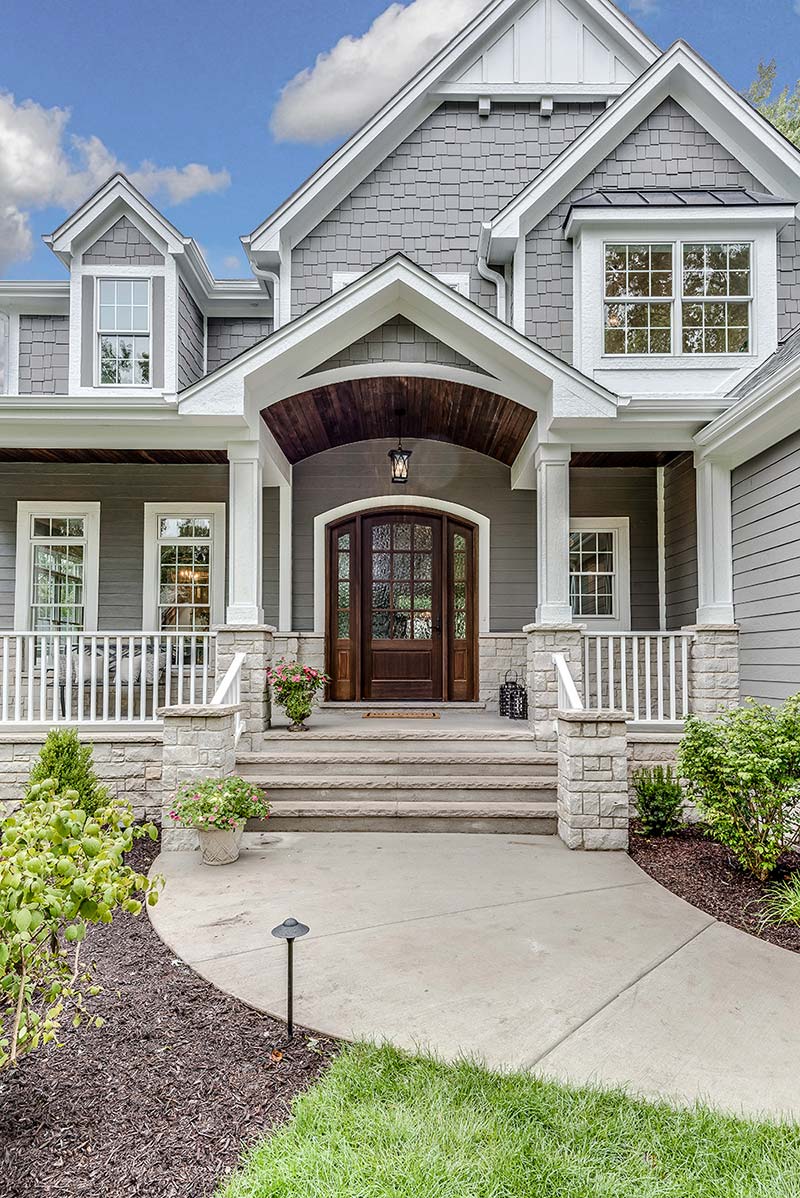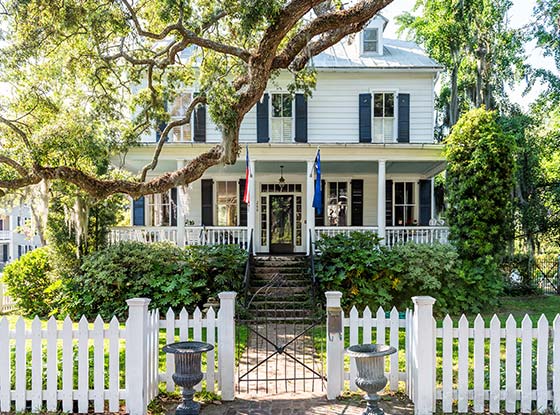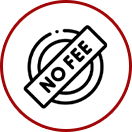Few purchases give you a sense of pride and accomplishment like buying a new home. From white picket fences and lush green grass to cookouts with neighbors and holidays with the family, owning a home is magical. Like most great things, though, enduring the home-buying process takes a lot of work. There are many steps to take and difficult decisions to make along the way. One of the most crucial decisions is what type of home loan and mortgage broker to choose. Whether it's your first time buying a home or you're a seasoned owner with multiple properties, you will need a trusted mortgage broker in Seabrook Island, SC, with your best interests at heart.
If you're like most people, you need a mortgage professional whose top priority is their customers - an expert who can provide accurate advice and guidance so you can make educated decisions. That's where Mission One Mortgage comes into the picture.
DifferenceThe Mission One Mortgage Difference

Whether you want the best interest rates or don't know where to start in the home-buying process, Mission One Mortgage can set you up in the right direction. From getting you pre-qualified to buy a home to securing a veteran's loan, Mission One Mortgage is the trusted solution you need. As Seabrook Island natives, we're proud to serve the Lowcountry and all of South Carolina with trusted mortgage brokerage services.
Unlike some mortgage companies in Seabrook Island, SC, we bring years of high-level experience and insight to the table. Having worked with hundreds of clients during our time in business, we know you're probably going through a range of emotions right now. Buying a new home can be a scary process, especially for first-time buyers. That's why we make every effort to make ourselves accessible and available for clients. Our primary goal is to help you make the right mortgage for your family and your budget.
Our Services
- Mortgage Broker Seabrook Island, SC
- The Mission One Mortgage Difference
- Why Should I Work with a Mortgage Broker in Seabrook Island, SC
- Exploring the Benefits of Working with a Mortgage Broker
- Common Home Loan Options in South Carolina
- Home Mortgage FAQs
- Mission One Mortgage: Turning Dreams into Reality, One Mortgage at a Time
Service Areas
We know that many home loan officers have horrible reputations. Some brokers only see their clients as transactions, and a means to make quick money. They come off as impatient and pushy, failing to understand that this is a very big decision for you. At Mission One Mortgage, we take the opposite approach. We encourage our clients to take as much time as needed to ask us questions and review mortgage documents. We could say that our mission is to exceed your expectations, but we'd rather just show you. From assistance finding FHA, VA, or other loans to refinancing your current mortgage, Mission One is the team you can trust.
Here are just a few reasons why home buyers choose Mission One Mortgage:
Why Should I Work with a Mortgage Broker in Seabrook Island, SC?

Most people simply don't have access to the hundreds of thousands of dollars needed to purchase a home with cash. Instead, they take out a mortgage loan to buy a home. Unfortunately, many homebuyers are anxious to get the ball rolling and, due to their excitement, fail to shop around for the best mortgage rates. To some degree, avoiding this step makes sense, as it requires a lot of legwork and research to get the job done. For those not wanting to spend hours researching a reasonable mortgage, there's an alternative to consider - working with a mortgage broker.

To understand the benefits of working with a mortgage broker, you must first understand their role in the home-buying process.
What Does a Mortgage Broker Do?
Your mortgage broker is a third party that works to connect you with mortgage lenders. Essentially, a mortgage broker works as an intermediary between a person who wants to buy a home and the entities offering loans to buy a home. The mortgage broker works with both the borrower and lender to get the borrower approved. They also verify and collect paperwork from the borrower that the lender needs to finish a home purchase. Typically, mortgage brokers have relationships with several home loan lenders. Mission One Mortgage, for example, has access to 50 different lenders, which gives us a wide range of home loans in Seabrook Island, SC, from which to choose.
In addition to finding a home loan lender, your mortgage broker will help you settle on the best loan options and interest rates for your budget. Ideally, your mortgage broker will take a great deal of stress and legwork off your plate while also potentially saving you money.
Help with the Pre-Approval Process
If you're ready to buy a home, getting pre-qualified is a great choice that will streamline the entire process. Your mortgage broker makes getting pre-approved easy by obtaining all the documents needed to get you pre-qualified. In taking a look at your application, they will determine if you're ready for the pre-approval process. If your application needs additional items, the mortgage company will help point you in the right direction to ensure your application is as strong as it can be. Your mortgage broker will also walk you through the different types of loans, from Conventional and FHA to VA and USDA.
In order to be pre-approved for a home in South Carolina, you must have the following:
- Two Years of W2 Forms
- 30 Days of Pay Stubs from Employer
- 60 Days of Bank Statements
- A Valid Driver's License
BenefitsExploring the Benefits of Workingwith a Mortgage Broker

Most people choose to use a mortgage broker because they have access to different lenders and interest rates. But a great mortgage broker brings more to the table than a choice of lenders.
Save You from Unneeded Stress:One of the biggest advantages of hiring a mortgage broker is that they can find and vet loans while managing the mortgage process on your behalf. The best mortgage companies, like Mission One Mortgage, hire brokers who are experts at keeping underwriting on track, coordinating with relevant parties, and handling all paperwork involved. At the end of the day, mortgage brokers save you stress and time and often expedite the closing process.
More Access: We touched on this earlier, but it bears repeating: A mortgage broker provides access to a range of loans, rates, and lenders. In fact, many mortgage brokers can get rates lower than what the average person could get from a lender.
Save You Money: There's a chance that your mortgage broker can get your mortgage fees reduced or waived by the lender, which could save you a good deal of money.
Help with Unfavorable Financial Situations: Expert mortgage brokers can often assist in challenging financial situations, like when a buyer has inconsistent income or less-than-perfect credit. Experienced brokers, like those at Mission One Mortgage, are often aware of lenders willing to will work with nontraditional borrowers.
Provide Key Insights: Mortgage brokers share important insights, such as your chances for a home loan approval and exactly how much house you can afford. They can also save you from making costly mistakes based on their years of expertise in the mortgage industry.

Home LoanCommon Home Loan Options in South Carolina

While settling on the best type of home loan isn't as exciting as searching for the home of your dreams, it's equally important. Yes, your Mission One Mortgage loan officer in Seabrook Island, SC, will be happy to help explain the differences between home loans. But understanding the basics ahead of time will save you stress and time in the long run.
Contact Us For Service !
Free Consultation (843) 822-5685
(843) 822-5685
Conventional Mortgages
Conventional loans can be used to purchase a new home or refinance your current one. Conventional loans include fixed-rate mortgages and adjustable-rate mortgages. Generally, borrowers must put down a 3% down payment for owner-occupants, 10% for a vacation property, and 20% for an investment home. If you are able to pay 20% of the total cost of the home, you can avoid private mortgage insurance, which is otherwise required. Conventional mortgages are often preferred by buyers with good credit or people needing a non-owner-occupied mortgage.


FHA Loans
FHA mortgages are issued by the U.S. government and backed by the Department of Housing & Urban Development (HUD). This loan is often preferred by first-time homebuyers because it only requires a 3.5% down payment and offers more flexibility with credit requirements and underwriting standards. FHA loans have several requirements you must meet to qualify. Contact Mission One Mortgage today to learn more about FHA loans and whether or not they're best for your financial situation.
USDA Loans
Also backed by the government, these loans are insured by the U.S. Department of Agriculture and don't require money down. These loans have lower insurance requirements when compared to FHA loans, offer 100% financing if you qualify, and allow for closing costs to be covered by the seller. In order to qualify for a USDA loan, you must live in a rural area, and your household income must meet certain standards. These loans are often preferred by low-income citizens who live in rural parts of South Carolina.


Veteran Mortgages
Also known as VA or Veteran's Affairs loans, these mortgages are reserved for the brave men and women who served in the military. VA loans help provide our military members, veterans, and their families with favorable loan terms and an easy home ownership experience. Often, those who qualify are not required to make a down payment on their home. Additionally, these loans often include less expensive closing costs.
If you are a veteran or the family member of a veteran, contact Mission One Mortgage today to speak with our Vetted VA Professional, Debbie Haberny. Debbie helps our military members, veterans, and their family members obtain home loans utilizing veteran benefits and would be happy to help as you search for a home.
FAQsHome Mortgage FAQs

Do you have questions about the complexities of mortgages and home loans? As your advocate, Mission One Mortgage is here to answer any questions you have about mortgages and the home-buying process. We encourage you to call our office to speak directly with one of our mortgage experts or continue reading below for answers to some frequently asked questions.
Q. I was talking to my spouse about mortgage brokers, and they mentioned the phrase home loan originator. What's the difference between a broker and a loan originator?
A. The mortgage industry is full of confusing jobs and titles, making it easy to confuse roles and responsibilities. Such is the case with mortgage brokers and home loan originators. Though their roles share similarities, a home loan originator in Seabrook Island, SC, works for a bank or credit union, while a mortgage broker works for a brokerage company. Home loan originators and mortgage brokers are both licensed by the Nationwide Multistate Licensing System (NMLS).
Q. I've heard from everyone that you must have mortgage insurance to buy a home. What is mortgage insurance?
A. Essentially, mortgage insurance helps protect lenders if a borrower forecloses on the home they bought. One advantage of mortgage insurance is that when borrowers pay it, lenders can often grant loans to buyers when they might not have otherwise. Though not always required to buy a home, mortgage insurance is often needed for down payments of less than 20%.
Q. I have just been pre-approved to buy a beautiful home in South Carolina. Is there anything I shouldn't do now that I'm pre-qualified?
A. Mortgage companies like Mission One Mortgage, make getting pre-qualified for a home easy. However, as your loan process continues, your lender is required to run a new credit report before closing on a home. For that reason, it's to avoid any activity that might affect your credit score, such as:
- Do not become a co-signer on a loan with someone else.
- Do not quit or change your job.
- Do not apply for new credit cards, automobile loans, or any other lines of credit.
- Do not use your credit card to pay for large purchases, like furniture for your new house.
- Do not avoid payments on current lines of credit, loans, or utility bills.
Q. My brother-in-law recently refinanced his home in South Carolina. What is refinancing, and should I consider refinancing my home too?
A. Refinancing your home basically means you're swapping your current mortgage for a new one, most often with a lower interest rate. If you would like to reduce the term of your loan, lower your monthly mortgage payments, or consolidate debt, refinancing may be a smart option. Many homeowners also choose to refinance if they want to switch from adjustable-rate mortgages to fixed-rate mortgages or to get cash back for home renovations. To learn whether refinancing is a viable option for your situation, contact Mission One Mortgage ASAP, as loan rates change frequently.
Mission One Mortgage: Turning Dreams into Reality, One Mortgage at a Time

Here at Mission One Mortgage, we believe that the best communities begin with the dream of home ownership. Our mission is to make those dreams come true, with personalized service, expert guidance, and good old-fashioned hard work. As one of the most trusted mortgage companies in Seabrook Island, SC, we have years of experience working with a diverse range of clients, from first-time buyers and investors to self-employed borrowers and non-native English speakers.
Though every mortgage situation is different, one thing never changes: our commitment to clients. Contact our office today to get started on an exceptional home-buying experience.
Contact Us For Service !
 (843) 822-5685
(843) 822-5685

Latest News in Seabrook Island, SC
Editorial: We dodged a bullet on Seabrook. Make sure it doesn't happen again.
THE EDITORIAL STAFFhttps://www.postandcourier.com/opinion/editorials/editorial-we-dodged-a-bullet-on-seabrook-make-sure-it-doesnt-happen-again/article_1c525744-4282-11ee-98c5-a71ff022b55a.html
Everyone who cares about southern Johns Island should be pleased that a controversial annexation was pulled from the Seabrook Island Town Council's agenda last week in the face of mounting opposition over what the annexation would help create — a new boat dock, private clubhouse, boathouse, pool house and 10 rental cottages — and the likelihood that it would add more traffic and pollution to the rural side of Charleston County's urban growth boundary.But those same folks, particularly leaders on Kiawah and Seabrook islands...
Everyone who cares about southern Johns Island should be pleased that a controversial annexation was pulled from the Seabrook Island Town Council's agenda last week in the face of mounting opposition over what the annexation would help create — a new boat dock, private clubhouse, boathouse, pool house and 10 rental cottages — and the likelihood that it would add more traffic and pollution to the rural side of Charleston County's urban growth boundary.
But those same folks, particularly leaders on Kiawah and Seabrook islands and Charleston County Council, should not get complacent. Instead, they need to work together on better planning to guide development in and around where those two sea islands meet up with southern Johns Island.
It's unclear when, or if, the developer's annexation request might resurface. Even if it doesn't, there undoubtedly will be other development plans that will expose the tensions between those living on rural Johns Island and those living beyond the gates at Kiawah and Seabrook. This moment offers an important reset, one that should begin with getting all these local governments to recommit to the vision of an urban growth boundary — a line past which suburban development would not be supported through zoning, infrastructure or other local policies.
Such a recommitment wouldn't bind future councils any more than their respective comprehensive plans do, but it would send a unified message about their mutual commitment to respect the natural beauty and environmental sensitivity of the area.
It's clear that development pressures at Kiawah's and Seabrook's doorstep are increasing. A fresh series of new developments, including a senior living facility and an emergency medical facility, is cropping up. Elected officials, neighborhood leaders and county planners need to come up with a mutually agreed-upon zoning overlay for the area, one that would guide future development to ensure new uses and the size and scale of new buildings are appropriate. Such an overlay also would prevent developers from trying to play one jurisdiction against another to get the permits they seek, a tactic sometimes used in other parts of the tri-county area.
The mutual interests of everyone became clear during this recent annexation controversy, as the mayor of Kiawah Island took the unusual step of sending a letter to Seabrook's mayor and council urging them to reject the annexation and respect the urban growth boundary, which Mayor John Labriola noted "serves as a guide to direct appropriate urban and suburban development while preserving and cherishing the rural charm of the Sea Islands that we all hold dear."
Given what we've seen this summer, the existing urban growth boundary line may not continue to be enough on its own, and we believe a joint planning effort could help pin down the following: to what extent commercial development in the greater Freshfields area should be allowed to inch its way north on Betsy Kerrison; whether the towns should annex any more of Johns Island; whether any upzoning in the area might be appropriate; and how new building would affect the net traffic and drainage needs around Kiawah and Seabrook. While residents live only on Kiawah or Seabrook or in the unincorporated area, they have a stake in the answers to all those questions. This area deserves a new zoning overlay and conservation goals that offer a shared vision of how the southern part of Johns Island will — and will not — change.
Regional planning needs to take place on a large scale — such as our greater metro area from Seabrook to Awendaw to Summerville and Moncks Corner — but it's also necessary on a smaller scale, especially in those places such as southern Johns Island where multiple local governmental jurisdictions meet.
Decades ago, the city of Charleston and Charleston County came up with the urban growth boundary across Johns Island and other areas where the suburbs ended to ensure their zoning and other policies worked together to protect rural areas that residents wanted to remain rural. Kiawah and Seabrook were once seen as too distant to bring into the conversation about that line. That's not the case any more.
Click here for more opinion content from The Post and Courier.
Get a weekly recap of South Carolina opinion and analysis from The Post and Courier in your inbox on Monday evenings.
Hicks: No smooth sailing in the forecast for Seabrook annexation plan
Brian Hickshttps://www.postandcourier.com/opinion/commentary/hicks-no-smooth-sailing-in-the-forecast-for-seabrook-annexation-plan/article_ffc62394-3845-11ee-8d6a-3b05f6c164e7.html
For its first annexation in more than 30 years, Seabrook Island’s Town Council picked a real doozy.Next week, council will likely vote to annex nearly 18 acres on Bohicket Creek — just across from neighboring Kiawah Island’s Town Hall — for a mixed-use development designed around a marina and private yacht club.The details are a tad fuzzy (well, as much as they can be with a 200-page proposal), but public sentiment is not.Nearly 600 residents have expressed concerns about the project’s poten...
For its first annexation in more than 30 years, Seabrook Island’s Town Council picked a real doozy.
Next week, council will likely vote to annex nearly 18 acres on Bohicket Creek — just across from neighboring Kiawah Island’s Town Hall — for a mixed-use development designed around a marina and private yacht club.
The details are a tad fuzzy (well, as much as they can be with a 200-page proposal), but public sentiment is not.
Nearly 600 residents have expressed concerns about the project’s potential environmental, traffic and flooding impact. That’s more than a quarter of the island’s full-time residents.
They've made it clear they don't want this, but feel like no one's listening.
“The vast majority of people have been opposed to this,” says island resident Paul McLaughlin. “They don’t have to listen to us, but don’t go and ask for our opinion if you don’t listen to the answers. It offers no benefit to us; it’s a private club.”
His frustration is understandable, because a lot of people have valid concerns.
The state already considers that stretch of Bohicket too contaminated for oyster harvesting; the feds say it’s not safe to eat fish caught there. The state turned down similar plans 30 years ago … which is about the last time Seabrook gave any thought to expanding its borders.
McLaughlin notes the developer's plan may address flooding on the property, but what does it do to the rest of the island?
Residents can't leverage their usual influence over local officials, several of whom publicly support the plan, because most of them aren’t running for reelection.
It’s sort of a perfect storm — and, on Seabrook, it’s definitely storm season.
Local government is usually the most responsive to local citizens. A couple dozen bicyclists can — and did — derail Charleston’s carefully negotiated plans to redesign downtown's King Street. But hundreds of well-heeled retirees can’t move the needle?
The island's planning commission recommended the annexation on a 4-1 vote in July over vocal opposition. Residents get one more chance next week at a public hearing prior to an initial annexation vote, but aren’t optimistic.
They’ll get 30 minutes — three minutes per speaker — to relay their concerns in a room that holds an audience of about 60. That's pretty standard operating procedure for local governments, but Seabrook residents are livid. The town, they say, has ignored repeated calls for a larger venue and more time.
Seabrook Mayor John Gregg says the developer has held informational meetings with residents for the past year, and when the island got the proposal in June, the town posted all documents online.
He says the alternative meeting venues suggested are all behind Seabrook’s private gate — and council meetings must be accessible to the public. Besides, he says, Town Hall is fitted with equipment to broadcast the meeting to the entire island.
If more people want to speak than time allows, the mayor says, speakers will be chosen by a random number algorithm generator.
That probably won’t make residents, or others, happy. Because this isn't just some not-in-my-backyard grousing. The Coastal Conservation League, the nonprofit Kiawah Conservancy and various Johns Island advocates have also objected. Even Kiawah has taken an unprecedented stand.
Earlier this month, Kiawah Mayor John D. Labriola and Town Council members sent a letter to Seabrook, publicly opposing the annexation.
“We strongly believe that maintaining the current [urban growth boundary] is critically important to protect the unique Sea Islands ecosystem and the rural character of the land outside the boundary for future generations,” Labriola wrote.
That's called foreshadowing.
Seabrook Councilwoman Jeri Finke wrote in the most recent issue of The Seabrooker that annexing the land gives the town control over it, which is better than allowing Charleston County or Kiawah to make the decisions. Her argument hasn't moved many.
That’s because Kiawah Mayor Labriola hit on a salient point. Since the land falls outside the urban growth boundary, its potential development would be fairly limited … if Seabrook just stayed out of this.
See, right now that land falls under county jurisdiction, and County Council would never ignore such a large and influential group of citizens.
But Seabrook’s annexation blocks county intervention because the town isn't party to the urban growth boundary agreement. That allows a few outgoing public officials to open the door to new development.
The Andell tract, as this land is called, sits at the end of Betsy Kerrison Parkway — an area just outside two wealthy communities under tremendous development pressure. Already, more businesses, a retirement community and an entire medical district are in the works.
But that land was never meant to be developed, at least not to this extent. That’s what the urban growth boundary dictates. The overdevelopment of Maybank Highway was meant as a trade-off to leave the rest of Johns Island largely rural.
Such plans often shrivel when there's money to be made — this is proof of that. But the marina development could also bring renewed scrutiny to the urban growth boundary and spark radical change ... because people are sick of overdevelopment.
But that's a story for another day.
At the hyper-local level, Seabrook officials should know their audience ... er, constituents. These are people who know how to get things done. They know how to file lawsuits. And they don’t give up.
So don’t expect next week’s vote to be the last word.
Get a weekly recap of South Carolina opinion and analysis from The Post and Courier in your inbox on Monday evenings.
Reach Brian Hicks at bhicks@postandcourier.com.
Plans for yacht club concerns sea island residents
Molly McBridehttps://www.live5news.com/2023/07/12/plans-yacht-club-concerns-sea-island-residents/
SEABROOK ISLAND, S.C. (WCSC) - The potential for a new yacht club and several docks on Seabrook Island is concerning Sea Islanders and environmental advocates.Town of Seabrook leaders discussed those plans Wednesday, which would include the annexation of a portion of Charleston County into Seabrook island.The town’s planning commission voted 4-1 to recommend moving forward with the annexation to the town council.The nearly 18-acre site, called the “Andell Tract,” sits between Bohicket Marina and Betsy K...
SEABROOK ISLAND, S.C. (WCSC) - The potential for a new yacht club and several docks on Seabrook Island is concerning Sea Islanders and environmental advocates.
Town of Seabrook leaders discussed those plans Wednesday, which would include the annexation of a portion of Charleston County into Seabrook island.
The town’s planning commission voted 4-1 to recommend moving forward with the annexation to the town council.
The nearly 18-acre site, called the “Andell Tract,” sits between Bohicket Marina and Betsy Kerrison Parkway on Johns Island.
the plan includes a private Yacht Club and amenities such as a boat house, pool house and detached hotel containing 10 two-story cottages, according to town documents.
It also has public spaces including a boardwalk, pathways and a community crabbing dock.
Dana Beach, the founder of the Coastal Conservation League, said his two main concerns about the proposal are the environmental impacts on the water, and the crossing of Charleston County’s Urban Growth Boundary.
He said if The Town of Seabrook annexes this portion of Charleston County into their town for development, it could set a precedent for other local municipalities to do the same.
“The town may say ‘this is only a 20-acre parcel that in itself isn’t a big deal,” Beach said. “That’s what Charleston could say if it wanted to coming down from the north, that’s what Kiawah could say as it comes in from the East, even Folly Beach could say that.”
Robby Maynor, the Communities and Transportation Program Director for Coastal Conservation League echoed Beach’s point while addressing the planning commission at Wednesday’s meeting.
“There is an ongoing effort for collaboration between the municipalities on the sea islands to reaffirm that growth boundary to help strike a balance between development and preservation, this annexation would be a step in the wrong direction,” Maynor said.
The majority of the 544 written comments and 10 in person comments were against the development, although some community members spoke in its’ favor.
“I believe a Yacht Club is an amenity that fits perfectly within our diverse group of people,” Seabrook resident, Jackie Helline, said.
Mike Shuler, the Owner and Managing Partner for Bohicket Marina Investors, said he respectfully disagrees with the fear that this annexation may set a precedent for other municipalities to cross Charleston County’s Urban Growth boundary.
“What we are annexing is part of Seabrook’s comprehensive plan. Whether it crosses an Urban Growth Boundary, in my opinion, isn’t relevant here,” Shuler said. “Not to mention, further expansion beyond the property we are contemplating here is not possible because of conservation easements that are in place.”
Copyright 2023 WCSC. All rights reserved.
Planned yacht club advances after Seabrook Island board OKs annexation, land use change
Warren L. Wise wwise@postandcourier.comhttps://www.postandcourier.com/business/real_estate/planned-yacht-club-advances-after-seabrook-island-board-oks-annexation-land-use-change/article_6433289a-20a9-11ee-a2bb-d718153d925d.html
SEABROOK ISLAND — Three decades after a plan to create a 400-slip marina through a canal and lock project on Johns Island was rejected, a scaled-down proposal calls for a private yacht club on nearly 18 acres in the same general area on Bohicket Creek.Conservationists and several area ...
SEABROOK ISLAND — Three decades after a plan to create a 400-slip marina through a canal and lock project on Johns Island was rejected, a scaled-down proposal calls for a private yacht club on nearly 18 acres in the same general area on Bohicket Creek.
Conservationists and several area residents oppose the development called Andell, but Seabook Island's Planning Commission voted 4-1 on July 12 to recommend annexing the site and zoning the property for a mixed-used development. Town council will have final say.
Bohicket Creek Investors LLC of Charleston wants to build a boat dock with a private clubhouse, boathouse and poolhouse along with outdoor amenities and 10 rental cottages for members and the public at 4484 Betsy Kerrison Parkway.
"Annexing gives Seabrook future control of the site," said Mike Shuler, the property owner's principal and managing partner. "It will substantially limit future development of the site."
The property, currently zoned for agricultural and residential use in unincorporated Charleston County, would allow "a variety of agricultural and light industrial uses ... which could have significantly greater impact on the existing natural features than the proposed development," according to the town's planning staff, which recommended conditional project approval.
Among those opposing the project is the Coastal Conservation League.
Robby Maynor, the Charleston-based environmental group's communities and transportation program director, said the project is outside the region's "urban growth boundary" and called the proposed development "a step in the opposite direction" of protecting rural acreage.
He also cited potentially adverse effects from pollution runoff into Bohicket Creek, increased boat traffic and encroachment into critical habitat areas.
A half dozen others cited similar concerns before the Planning Commission's vote. The board also noted it had received more than 500 comments about the proposal with the vast majority in opposition.
Proponents of the project said that the property's current zoning allows multiple uses than what's being proposed, that the town will have more control over the property if it is annexed and that the development will provide recreational opportunities.
Get the best of the Post and Courier's Real Estate news, handpicked and delivered to your inbox each Saturday.
The project's name is similar to a proposed development from 30 years ago called Andell Harbor that called for a massive earth-moving operation with a man-made channel connecting to a large marina. State environmental regulators eventually nixed the idea in the mid-1990s.
The yacht club site is beside Bohicket Marina, which also is owned by Shuler's group, and the two would be connected by a boardwalk and road. The planned entrance to the new development is across from Kiawah Island Town Hall.
Cottages would flank both sides of the drive leading to the yacht club.
Plans show the development on about 4 acres of the site near the creek. The rest of the property would be set aside as open space, including a 75-foot wooded buffer next to the parkway and a 20-foot vegetated area next to the northwest parcel in the county.
The site also would include a public boardwalk, pathways and a community crabbing dock.
Bohicket Creek Investors bought the tract in 2021 for $5.6 million, according to Charleston County land records. Nearby properties include Freshfields Village Shopping Center.
Bohicket Marina, which is in the town of Seabrook Island, is southwest of the proposed development.
If the property is annexed into the town, it would tie into the town's sewer system, with St. John's Water Co. proving water service
The yacht club would be separate from the community and recreational facilities provided by Seabrook Island Property Owners Association and Seabrook Island Club.
Town Council is scheduled to review the proposal on Aug. 22. The measure requires a public hearing and two majority votes in separate meetings to pass.
How Audubon South Carolina Protects Their Coastal Birds and the Places They Need
Audubonhttps://www.audubon.org/news/how-audubon-south-carolina-protects-their-coastal-birds-and-places-they-need
With their Shorebird Stewardship program, Audubon South Carolina protects Red Knots, American Oystercatchers, and other birds that find respite on their shores. Words by Gabrielle SalehSenior Coordinator of Social Media, National Audubon Society Published June 01, 2023 Maybe it’s seeing the first rays of sunlight peeki...
With their Shorebird Stewardship program, Audubon South Carolina protects Red Knots, American Oystercatchers, and other birds that find respite on their shores.
Words by Gabrielle Saleh
Senior Coordinator of Social Media, National Audubon Society
Published June 01, 2023
Maybe it’s seeing the first rays of sunlight peeking over the horizon while Sanderlings and Willets scamper on the sand sneaking bites to eat, or hearing the calls of Laughing Gulls overhead as Black Skimmers bark in the background—or the fact that I haven’t visited a beach in years—but sunrise at the beach is a magical experience.
This morning, I’m in Charleston, South Carolina exploring Seabrook Island’s coast with my Audubon colleagues. We’re searching for migrating Red Knots, a shorebird that stops over parts of the Atlantic Coast along its 9,000-mile journey to nest in the Arctic. (You can discover its full migration journey with the Bird Migration Explorer.)
Seabrook Island and its neighbor Kiawah Island are two key beaches that the species relies on for survival. Early May is horseshoe crab spawning season, which means the wet sand along islands nearby is filled with their eggs, and outside of spawning, Seabrook Island is rich with donax clams. Horseshoe crab eggs and donax clams are what sustain the knots as they prepare to fly the remainder of their journey to their breeding grounds.
"We get about 40% of the Red Knot Atlantic Coast population—that’s [over] 17,000 birds—that stop on Seabrook and Kiawah Islands in the springtime,” says Allyssa Zebrowski, Audubon South Carolina’s coastal stewardship coordinator.
Like Red Knots, endangered Piping Plovers use South Carolina beaches to rest and feed through the winter before making their way up north to breed. State-threatened Wilson’s Plovers raise their young here—so do state-threatened Least Terns—and 1/3 of the American Oystercatcher’s population find respite on these shores in the winter.
Human disturbance is one of the greatest threats these birds face along the nearly 3,000 miles of South Carolina’s tidal shorelines, whether that’s people walking through resting flocks or unleashed dogs getting too close to nesting birds. That’s why in 2016 Audubon South Carolina launched its Shorebird Stewardship program to conserve these five vulnerable focal species and other coastal birds by educating people about them.
“What started as a seasonal program led into a year-round need for stewardship,” says Nolan Schillerstrom, Audubon South Carolina’s coastal program associate. “We realized…that it really needed a year-round effort, not only to focus on the non-breeding birds but to continue the momentum from year to year.”
Now, depending on the year, Audubon South Carolina sends volunteers called Shorebird Stewards to 10 to 13 different coastal sites to prevent human disturbance. The stewards undergo training each year to learn more about coastal birds and their behaviors. They also are trained on how to talk to beachgoers to get them to care about the birds. Plus, they help post signs alerting people to birds nesting or resting nearby.
“It’s all about getting out there, watching out for the birds, and telling other people to [be mindful of] the birds,” says Zebrowski.
The Shorebird Stewardship program works with a variety of partners to reduce human disturbance, including Seabrook Island Birders, which runs the volunteer program at their beach site.
We’re joined by a couple of the birders today on our walk to find the Red Knots. Many of the beachgoers they encounter are their neighbors and visitors to the private island, so they have their own way of telling people to look out for the birds.
“I like to tell people a story about the birds to make them feel sympathetic towards them,” says Lesley Gore, one of the program coordinators. “I’ll tell them how many miles the Red Knots are going to fly and that it’s very important for them to gain their weight [undisturbed].”
It’s clear that stewardship plays a vital role in protecting beach birds across the country. A recent study led by Audubon’s science team found that four vulnerable coastal bird species’ populations grew 2 to 34 times faster at stewardship sites rather than birds in only protected areas.
Audubon South Carolina is already seeing positive results from the program. “We do see the improved nesting success of the American Oystercatcher, the Wilson’s Plover, and the Least Tern [at sites we help manage],” says Zebrowski. That nesting success is combined with the program’s growing number of volunteers and increased notoriety each year.
And it’s a good thing too, because shorebirds as a whole are at risk in North America. In fact, the continent’s shorebirds have declined by 70% since the 1970s.
“That’s the stat that we always think of when we’re on the ground,” says Schillerstrom. “We want to tern that around and give these birds a fighting chance here on the beach.”
After passing breeding American Oystercatcher pairs, diving Brown Pelicans, and soaring Osprey, we finally reach an inlet that gives us a view of the Red Knots, though they’re on Kiawah Island today. We watch them huddle en masse on the shoreline, preening and calling.
To be able to capture photos and footage, from a safe distance, we visit Kiawah Island the next day and make another trek in hopes of catching the knots at the right time. At first, we find them across the inlet on Seabrook Island, but suddenly, when the tide rises to the perfect height, the birds flock to the sky, flying back and forth over the water uniformly as they murmurate, creating mesmerizing patterns with their striking orange bellies and mottled gray backs.
They land on our side of the inlet, on Kiawah, and begin running along the shoreline, giving us the perfect opportunity to capture their essence. I watch their activity in awe, knowing that in just a few weeks, they will be making the last leg of their journey up north to breed. It reminds me of why we must all do our part to protect them so that they can exist for future generations.
I’m also reminded of a conversation we had with a shorebird steward volunteer, Nancy Chomel, who we met the day before at Seabrook Island. When asked what makes her passionate about protecting coastal birds, she replies, “In saving the birds, we save ourselves.”
Isn’t that what it’s all about?
To learn more about Audubon South Carolina’s coastal conservation efforts, including how to become a volunteer Shorebird Steward, visit their website.
Disclaimer:





